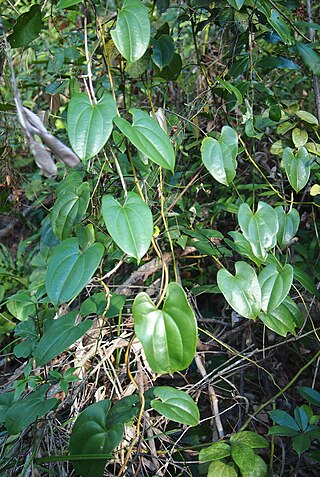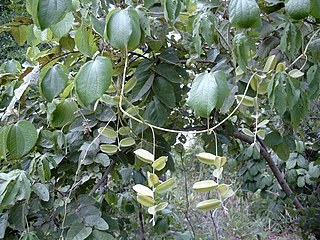
Dioscorea alata – also called purple yam, ube, or greater yam, among many other names – is a species of yam. The tubers are usually a vivid violet-purple to bright lavender in color, but some range in color from cream to plain white. It is sometimes confused with taro and the Okinawa sweet potato beniimo (紅芋), however D. alata is also grown in Okinawa. With its origins in the Asian tropics, D. alata has been known to humans since ancient times.

Dioscorea is a genus of over 600 species of flowering plants in the family Dioscoreaceae, native throughout the tropical and warm temperate regions of the world. The vast majority of the species are tropical, with only a few species extending into temperate climates. It was named by the monk Charles Plumier after the ancient Greek physician and botanist Dioscorides.

Dioscorea communis or Tamus communis is a species of flowering plant in the yam family Dioscoreaceae and is commonly known as black bryony, lady's-seal or black bindweed.

Dioscorea polystachya or Chinese yam, also called cinnamon-vine, is a species of flowering plant in the yam family. It is sometimes called Chinese potato or by its Korean name ma. It is also called huaishan in Mandarin and wàaih sāan in Cantonese.

Dioscorea bulbifera is a species of true yam in the yam family, Dioscoreaceae. It is native to Africa, Asia and northern Australia. It is widely cultivated and has become naturalized in many regions.

Widdringtonia wallichii, Clanwilliam cedar or Clanwilliam cypress, previously Widdringtonia cedarbergensis is a species of Widdringtonia native to South Africa, where it is endemic to the Cederberg Mountains northeast of Cape Town in Western Cape Province. Due to harsh weather conditions, like limited rainfall and frequent wildfires, growth is limited. Ring width almost correlates with rainfall due to such harsh environmental conditions It is threatened by habitat loss and protected in South Africa under the National Forest Act of 1998.

Sorbus wallichii is a species of plant in the family Rosaceae. It is found in China, India, and Nepal.

Dioscorea transversa, the pencil yam, is a vine of eastern and northern Australia.
Dioscorea orangeana, is a tuberous vining flowering plant in the genus Dioscorea, endemic the Forêt d’Orangea near Antsiranana in Madagascar, from which it derives its name. The tuber is possibly edible, and unlike most other Dioscorea species, the tuber has many finger-like lobes as opposed to a single tuber. Because the plant is new to science and the possible harvesting by local populations, the conservation status of Dioscorea orangeana is of great concern.

Dioscorea pentaphylla is a species of flowering plant in the yam family known by the common name fiveleaf yam. It is native to southern and eastern Asia as well as New Guinea and northern Australia. It is widely cultivated as a food crop and naturalized in Cuba and on several island chains in the Pacific.

Dioscorea sansibarensis is a species of flowering plant in the yam family known by the common name Zanzibar yam. It is native to Madagascar and to tropical Africa from Tanzania west to Guinea and south to Mozambique, and it is known elsewhere as an introduced species.

Dioscorea dumetorum, also known as the bitter yam, cluster yam, trifoliate yam, or three-leaved yam, is a species of flowering plant in the yam family, Dioscorea. It is native to sub-Saharan Africa and especially common in the tropical regions of West Africa, including Nigeria, Benin, and Ghana. D. dumetorum has both toxic and non-toxic varieties.

Dioscorea quartiniana is a climbing tuber geophyte in the family Dioscoreaceae. It is native to Benin, Botswana, Burundi, Chad, Congo, Côte d'Ivoire, Eritrea, Ethiopia, Gambia, Ghana, Kenya, Madagascar, Malawi, Mozambique, Namibia, Nigeria, Rwanda, Sierra Leone, South Africa, Sudan, Tanzania, Uganda, Zambia, and Zimbabwe. This species occurs in forests, grasslands, and rocky areas.
Dioscorea trilinguis is a climbing tuberous geophyte in the family Dioscoreaceae. It is native to southeastern Brazil, and is found growing in tropical forests, dry forests, and on clay soil.
Dioscorea abyssinica is a herbaceous vine in the genus Dioscorea native to several Central African countries including Benin, Burkina Faso, Central African Republic, Eritrea, Ethiopia, Ghana, Ivory Coast, Liberia, Mali, Nigeria, Senegal, and Sudan. The plant's starchy tubers are edible and are either harvested from the wild or cultivated; however, they are difficult to obtain due to the depth at which they grow in the soil. It is propagated by seed.
Dioscorea acuminata is a herbaceous vine in the family Dioscoreaceae, which is listed as an endangered species by the IUCN Red List. It is indigenous to the central plateau of Madagascar where it occurs on rocky substrate in a grassland-woodland mosaic habitat. There is confusion as to whether the tuber is harvested for consumption by humans as field researchers likely misidentified Dioscorea maciba as this species. However, the IUCN Red List also has an entry for D. maciba which does not cite that species as being consumed by humans.
Dioscorea alatipes is a herbaceous vine in the genus Dioscorea. It is indigenous to the Morondava Prefecture in Madagascar and is listed as an vulnerable on the IUCN Red List in 2017, having previously been listed as endangered in 2001. It has been confused with another Dioscorea species, D. bako which is a food source of the indigenous people of the region. D. alatipes is found growing in forested areas on sandy soils or on limestone substrate. This species is managed for human consumption as part of the SuLaMa Project. According to the IUCN, the species is threatened by overharvesting of the tubers as well as by the expansion of farmland in the area.
Dioscorea ancachsensis is a herbaceous plant in the genus Dioscorea that is native to Peru. It is uncertain if these specimens are mature, but they are distinct from most specimens of most Dioscorea species in that they are approximately 5 cm across. One such specimen, collected from an open hillside in Cuzco, includes foliage, flowers, and a tuber and is approximately 4 by 5 cm when pressed.
Dioscorea strydomiana is a critically endangered species of yam from South Africa with fewer than 250 mature individuals known to exist.

Dioscorea deltoidea, the Nepal yam, is a species of flowering plant in the family Dioscoreaceae. Its native range is the Himalayas through to south-central China and mainland Southeast Asia. Its tubers contain diosgenin and are harvested by local peoples as a treatment for a variety of conditions, including gastrointestinal disorders and intestinal worms. Tubers are also eaten after boiling, washing, and baking. It grows in forests and humus-rich soils.













